1. Problem: The challenge the project addresses
SuperAdobe structures have been built in 54 countries all around the world. Often in distaster-struck or remote places where there is no acces to electricity.
Being off-grid means being dependent on other sources of energy, like wind and solar. When the sky is cloudy, the production of solar panels diminishes quickly. When not complemented with batteries, there is also no power at night when using solar only. This is why solar and windpower are complementary. There is also the problem of plastic waste. In many countries plastics are just dumped into wastelands.
2. Solution: How the project will alleviate or solve the problem
The Propel-E 450 produces enough electricity for the basic needs of a small household, for example powering a fridge, an infrared heater or lighting. The Propel-E 450 can quickly and easily be mass-produced through crowdsourcing. This approach has recently proved to work, where the 3D-printing community resolved the shortage of Covid-19 faceshields. The windturbine can be printed in a few days with any household 3D-printer.
It has a very sturdy design with as less components as possible, while still ensuring maximum power output.
i. Design process & design decisions
---- Material choice ----
The Propel-E 450 is made from PLA, wich is one of the stiffest plastics (tensile modulus of 3,5MPa). It also brakes down much faster than regular plastic when burried in organic matter. If a windturbine would be disposed or broken down, the copper and the magnets can be recycled, and the PLA breaks down.
With a good solvent, other materials like PET(G), or ABS (dissolves in aceton), can also be used. For example, we designed a smaller windturbine made from recycled PET-bottles: https://hackaday.io/project/174283
The Propel-E 450 has been tested in different environments, including weather as hot as 38°C.
---- Wing design -----
We opted for fixed blades, meaning the blades are attached to the axle. Disadvantages of adjustable blades, like being prone to damage and increased material and maintenance costs do not add up to the advantage of having the blade angle perfect everytime. Also, a near-perfect blade can be made by twisting the blade along its length. Because of this, fixed blades have become the mainstream in the wind DIY-community.
To be sure we have the correct twist and taper, we used Hugh Piggot's Blade Design spreadsheet. Furthermore we choose the NACA 4415 airfoil for its good suitability for small windturbines.
We modeled the entire blade in Fusion360, with some small tweaks in 3DS Max.
To safeguard birds, recent studies have showed that colouring 1 blade black decreases fatalities significantly. One of our Patreon-supporters is currently working on this:
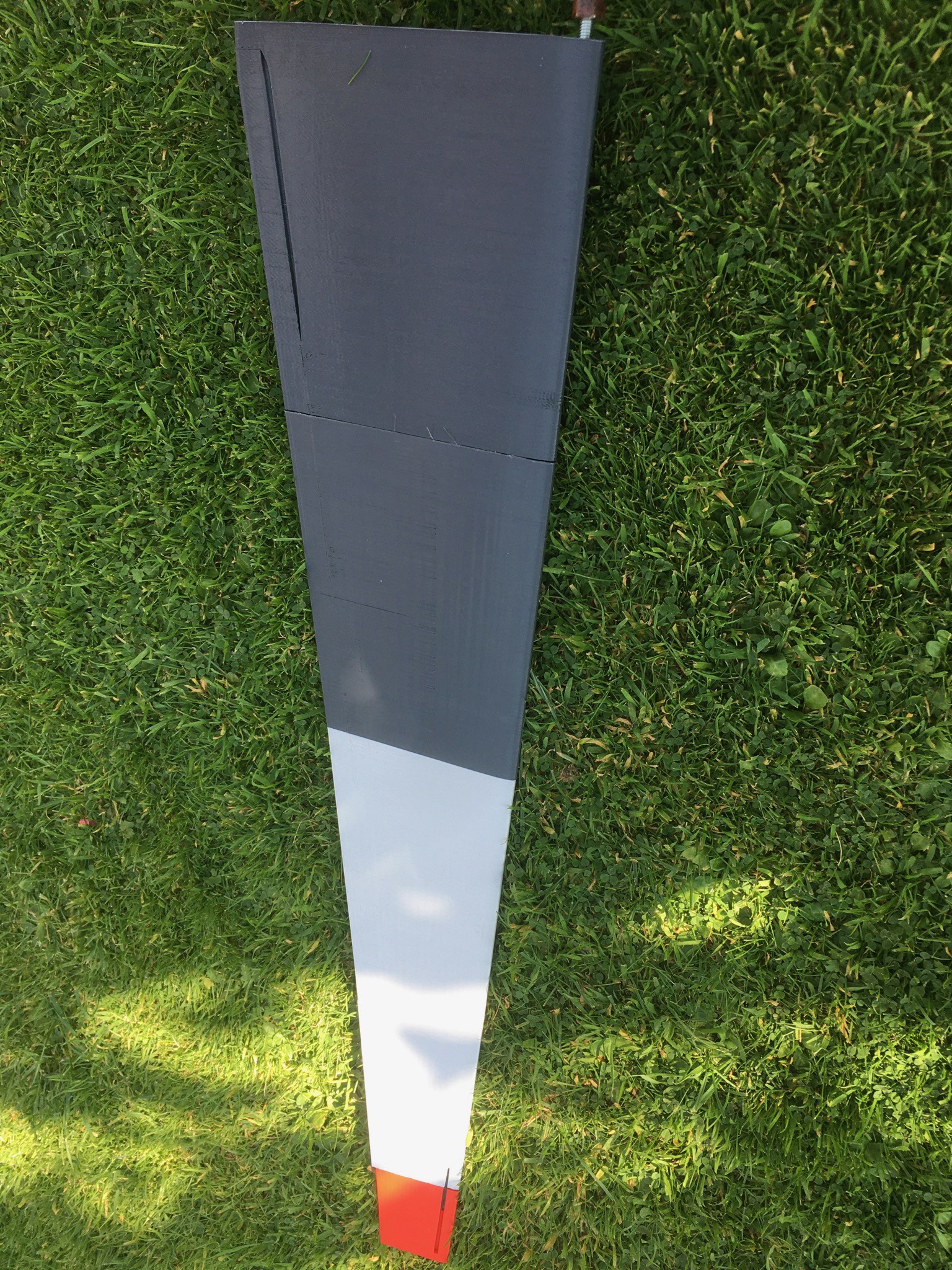
For bats there is only an issue if there is a vacuum behind the blades, which only is the case with big industrial windturbines having blade diameters of >60m. (Bats are, unlike birds, mammals and have weaker lungs that implode after fying through the vacuum. After a few 100 meters, they drop dead out of the sky because of oxygen depletion).
Other studies have selected purple for all 3 the blades as the best colour for both bat and birds (study on big industrial windturbines of >60m).
----- Alternator design -----
We choose for an air-core 3-phase axial flux alternator because it is perfectly suited for windturbines. The air-core makes that the windturbine starts very easy, and the 3-phase star connection reduces vibrations and makes the turbine more efficient when the current is rectified for battery charging.
Therefore we decided to base the design of the alternator on the 2F Ferrite Windturbine from Scoraigwind. It uses ferrite magnets that are not relying on rare minerals like neodymium magnets do, which makes the windturbine even more environment-friendly. Ferrite magnets are also not prone to humidity, which is an often seen issue with neodymium magnets.
To provide enough strength we shifted the magnets and coils 1,5cm outwart, away from the axle, so there is enough plastic between the magnets.
The power curve is shown below:
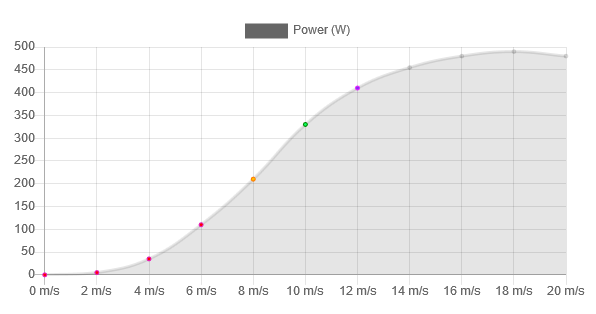
SAFETY WARNING: When unloaded, this alternator might reach hazardous voltages over 50V DC. Don't touch the wires when the windturbine is spinning free in stormy weather. Unloaded, it will also reach a dangerously high RPM, with danger for blade collision with the tower or rupturing of the blades. Therefore alway connect a controller, a resistive load, or shortcircuit the phases!
----- Battery and controller -----
A windturbinecontroller for charging batteries needs to have 3 main functions:
- 3-phase rectifier: to convert the 3-phase AC into DC for the battery, a diode bridge is needed:
- Charge controller: the battery needs to be charged at the correct voltage (13,5V-14,5V)
- Discharge controller: deep discharge damages the battery, so it has to be switched off at the appropriate level (around 12,6V unloaded at room temperature).
- Dump load: when the battery is full, the rest of the power needs to be diverted to prevent overcharging the battery. The most common application is to dump it into resistors. Just disconnecting with a switch is not enough as it would make the windturbine runaway with a too high RPM, leading to self-destruction.
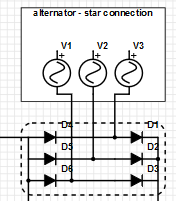
We designed our own controller around an Arduino to provide these functions:
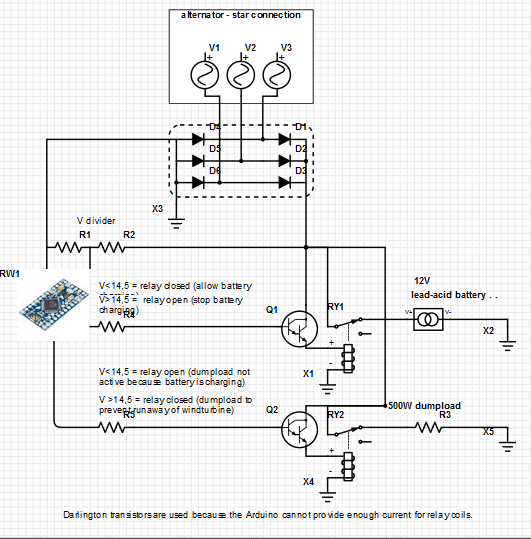
Although this controller worked fine, it set's you back 25EUR in parts, labour not included. That is if you don't make any mistake.. Therefore the cheap (Asian) controllers we mentioned in our previous post are also worthwile looking into. There are a lot of deviations of the same controller to be found on marketplaces like Alibaba, Amazon, Ebay,.. Often relabeled with a fancy brandname and then sold for twice or even quadruple the original price.
We ended up buying this one for only 10,89EUR on Amazon.de: "Zerodis Wind Charge Controller Wind Regulator Charge controller with self and hand brake function Waterproof 400W (12V)".
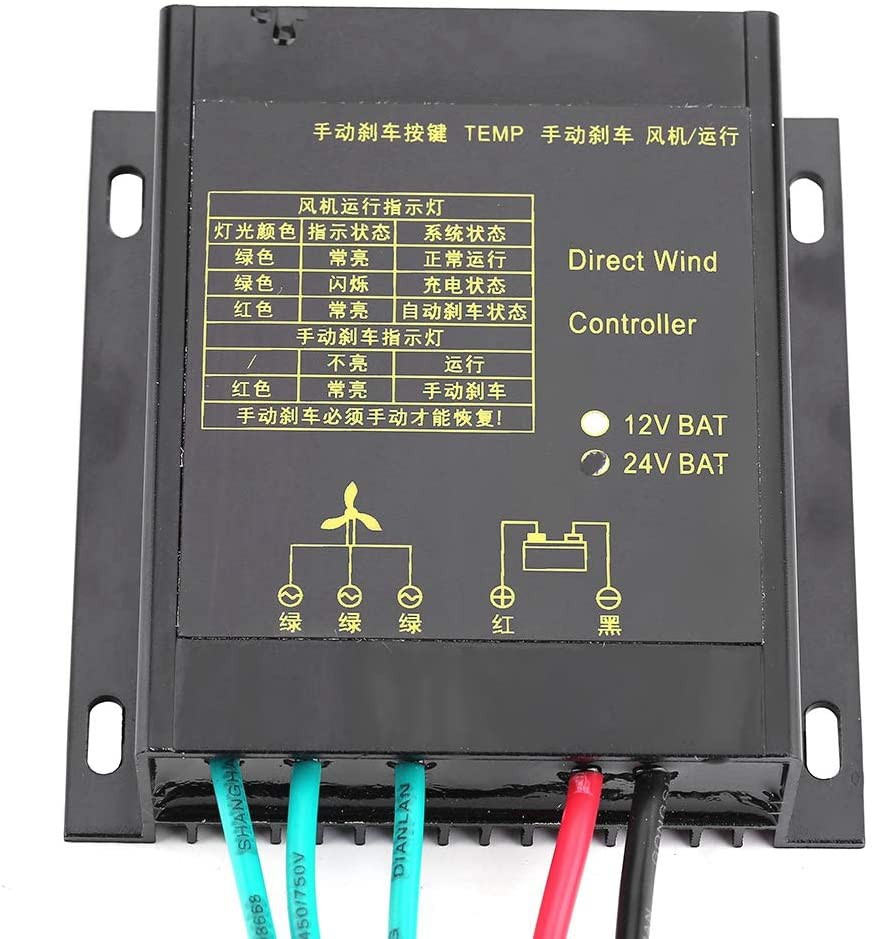
With the use of the Google Translate app and some basic reasoning we were able to understand the labeling and how the controller works:

It works fine and even has a button to manually control the braking (=dump load) for maintenance.
Another controller that came in was the "Zerodis 12V / 24V 300W wind turbine generator lader controller". It's named Zerodis, but actually it was just the cheapest rebrand we could find, underneath it's all Chinese. It came in for 28EUR, and there is clearly a quality difference: the cables are thicker, and the heatsink of the dump load is also way bigger dimensioned.
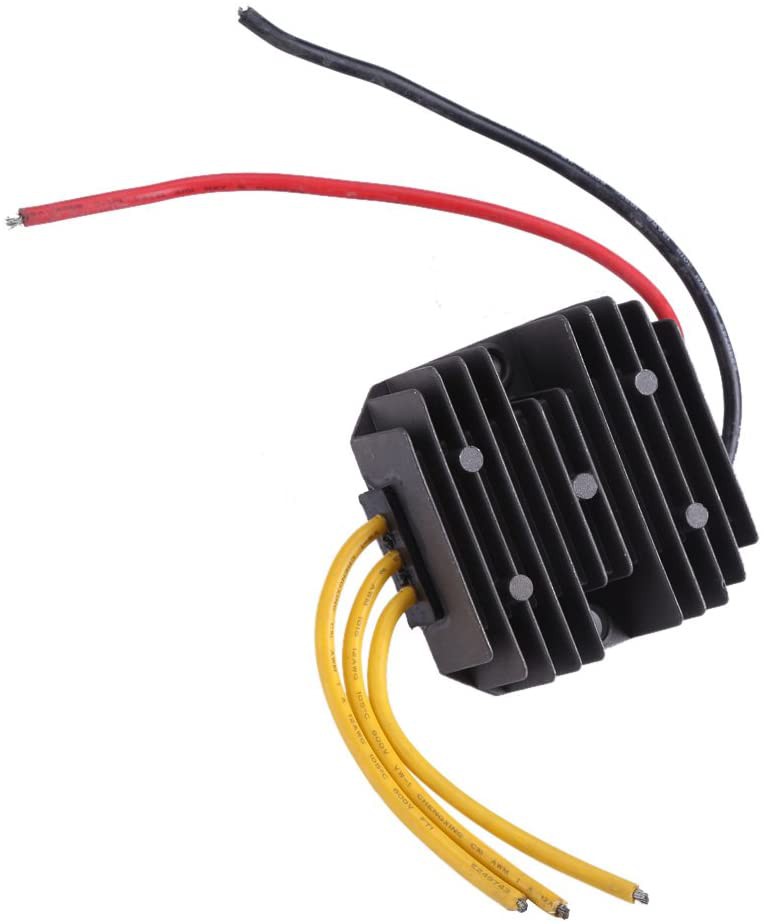
It works just fine (for now?) and runs cooler than the other controller thanks to the bigger heatsink.
Unfortunately, none of these commercial controllers have a function that protects the battery agains overdischarge. Therefore we added an additional unit, bought seperately for around 10EUR on Amazon:
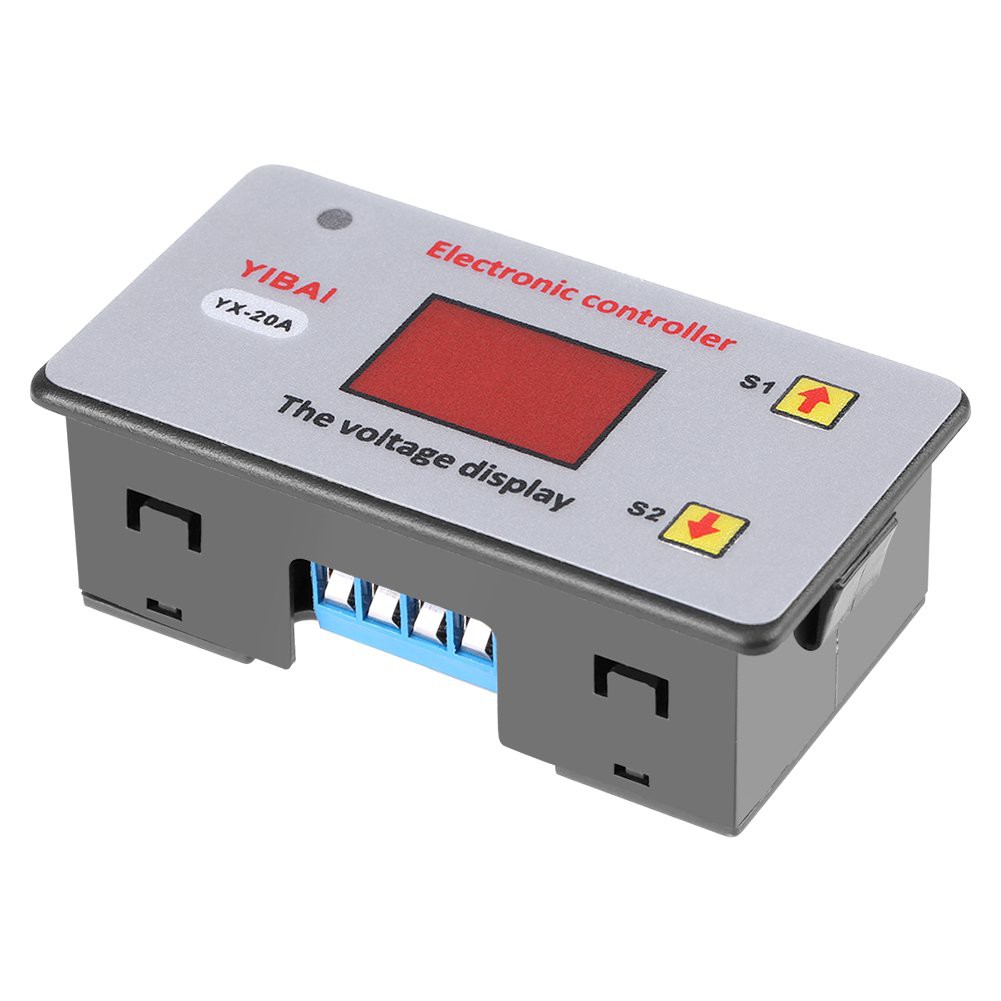
It does the job but relates battery charge only to the battery voltage. This means that if you connect a high power load, the voltage also drops, triggering a false 'empty battery' alarm. There are more intelligent discharge controllers on the market or to be made, that also measure the current that the load is drawing, but these cost a multitude of the price.
This is how it looks like al wired together. (The 3-phase current from the windturbine comes in through the thick black cable)
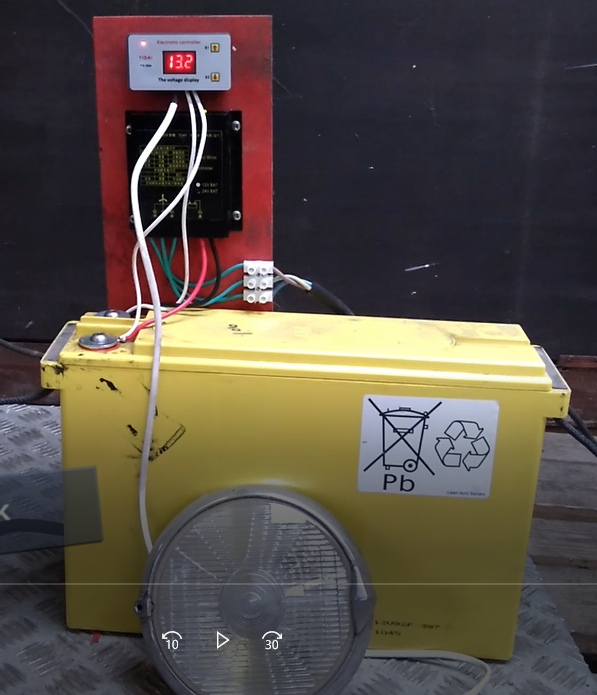
SAFETY WARNING: To prevent fire when shortcircuited, put a fuse just after the battery terminal. This component has not been included in the schematic yet.
----- Tower mount -----
The Propel-E 450 can be fit on any tower with a hole for a 20mm threaded rod.
SAFETY WARNING: To prevent children or animals climbing up the tower and getting harmed, proper fencing needs to be installed.
ii. How ready is this design to be manufactured?
The 3D-files of each part can be downloaded for free and are optimized to be printable on each household 3D-printer. The other parts are easy to find on the internet (laquered copper wire of 1,6mm diameter, ferrite magnets and standard bearings).
For deployment in emergency areas, the windturbines can be quickly mass produces by the maker-community, similar as happened with the covid-faceshields shortage. Also and foremost, specialised organisations like Field Ready might be suited to rapidly produce the Propel-E 450.
iv. How complete is the project?
A first prototype of the Propel-E 450 has been made for the entry round, and now the final version with improvements like better bearings, better bearing fitting, better weatherproofing, support for different controllers, .. is ready.
When fitted on a tower, connected to a battery and a controller, it is a complete kit ready to be installed next to any SuperAdobe structure. (It's not advisable to connect the pole to the dome since
noise will travel through the solid structures.)
Licenses: Everything is under CC BY-NC-SA (Creative Commons Attribution-NonCommercial-ShareAlike) license, enjoy!
 Bram Peirs @ FW2W
Bram Peirs @ FW2W